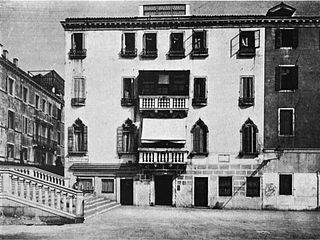
Palazzo Molina or Palace of Two Towers or Palazzo Navager is a Gothic style palace located on the Riva degli Schiavoni #4145 in the sestiere of Castello, Venice, adjacent to the Ponte del Sepolcro, previously called the Bridge of Ca'Navager. It is best known for being the home, for about five years, of the poet Petrarch.

Ca' Vendramin Calergi is a 15th-century palace on the Grand Canal in the sestiere (quarter) of Cannaregio in Venice, northern Italy. It was commissioned by the patrician Loredan dynasty, namely Andrea Loredan, and paid for by Doge Leonardo Loredan, with construction starting in 1481. The architecturally distinguished building was the home of many prominent people through history, and is remembered as the place where composer Richard Wagner died.

The Palazzo Barbarigo Minotto is a 15th-century palace on the Grand Canal in Venice, northern Italy, next to the much larger Palazzo Corner. Built in the Venetian Gothic style, it was originally two palaces, Palazzo Barbarigo and Palazzo Minotto, later joined together. The Barbarigo palace was owned by the Barbarigo family for several centuries and was the birthplace of Gregorio Barbarigo, who once refused the Papal Crown. It was later owned by the Minotto and Martinengo families.

Ca' Farsetti is a palace in Venice, Italy. It is located in the sestiere (district) of San Marco, and faces the Grand Canal, not far from the Ponte di Rialto.
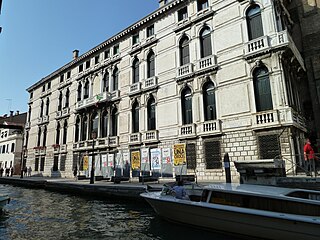
The Palazzo da Lezze or Ca' Lezze is a Baroque palace in Sestiere of Cannaregio in the city of Venice, Italy. It is located on Rio della Misericordia, with a facade on the fondamenta (canal-sidewalk), and stands between the Scuola Grande Nuova della Misericordia and Calle Largo Lezze.

The Palazzo Michiel Dalle Colonne is a Baroque style palace located on the northern bank of the Grand Canal in the sestiere of Cannaregio in Venice, Italy. It is one building south of the junction of Rio del Santissimi Apostoli with Grand Canal, next to the Palazzo Michiel del Brusà and across the Canal from the Rialto Mercato and the Campo della Pescaria. The palace is also referred to as Palazzo Michiel Dalle Colonne a Santa Sofia.
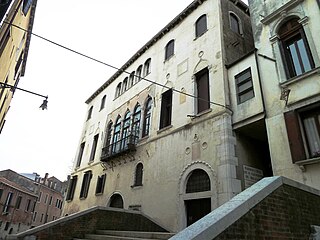
The Palazzo Grandiben Negri is a small brick palace located facing the Rio of Ca' di Dio, adjacent to the larger Palazzo Erizzo, and diagonally across the rear of the church of San Martino in the sestiere of Castello in Venice, Italy.

The Palazzo Erizzo, also known as the Palazzo Erizzo a San Martino, is a palace located in the sestiere of Castello, adjacent to the south with the Palazzo Grandiben Negri, and across a Rio from the church of San Martino in Venice, Italy. A second Palazzo Erizzo alla Maddalena is located on the Grand Canal of Venice.

The Palazzo Manfrin Venier, once known as the Palazzo Priuli a Cannaregio or Palazzo Priuli Manfrin, is a Baroque-style palace located facing the Cannaregio Canal in the sestiere of Cannaregio of Venice, Italy. It stands to the left of the Palazzo Savorgnan.
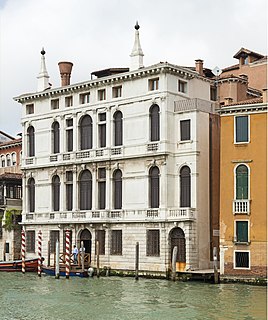
The Palazzo Giustinian Lolin is a Baroque style palace located on the Grand Canal of Venice, Italy. The present facade was designed circa 1630 by Baldassare Longhena. It is used as an exhibition venue for the Venice Biennale.

The Palazzo Priuli Stazio is a Baroque architecture palace located near San Giacomo dall'Orio in the sestiere of Santa Croce in Venice, Italy.
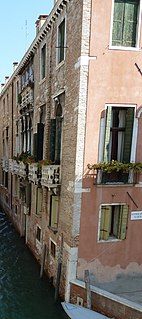
The Palazzo Donà-Ottobon is a palace located at Calle della Madonna on the Fondamenta di San Severo, corner with and Calle Larga San Lorenzo, in the Sestiere of Castello in Venice, Italy. The remains of this Venetian Gothic architecture palace are a small corner facade, alongside a canal, with two and a half walled-up gothic arcades in the piano nobile. The portal has an equally awkward marble relief of the Virgin with St Francis, St Claire de Montefalco, and a donor of reduced size. Earlier authors do not mention this portal.

The Palazzo Girardi Zecchini or Benzi Zecchini all Madonna dell'Orto is a 15th-century palace located near the church of Madonna dell'Orto in the sestiere of Cannaregio of Venice, Italy.
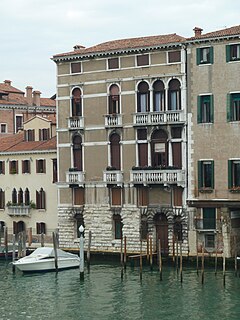
The Palazzo Boldù a San Felice is a palace located on the Canal Grande of Venice, between the Palazzetto Da Lezze and Palazzo Contarini Pisani in the Sestiere of Cannaregio, Venice, Italy.
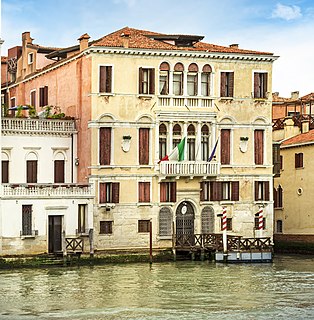
The Palazzo Gussoni Grimani Della Vida, also called Grimani a San Fosca is a Renaissance-style palace on the Grand Canal, located between the Palazetto Barbarigo and the Rio di Noale, in the sestiere of Cannaregio, in Venice, Italy.

The Palazzo Bernardo a San Polo, also known as the Giustinian Bernardo is a Gothic-style palace located between Palazzo Querini Dubois and across the Rio del la Madoneta, Casa Sicher, on the Grand Canal in the sestiere of San Polo of Venice, Italy.

Palazzo D'Anna Viaro Martinengo Volpi di Misurata, also known as Palazzo Talenti D'Anna Volpi, is a Renaissance palace in Venice, Italy, located in the San Marco district, overlooking the left side of the Grand Canal, between Palazzo Tron and Casa Marinoni and opposite of Palazzo Donà a Sant'Aponal.
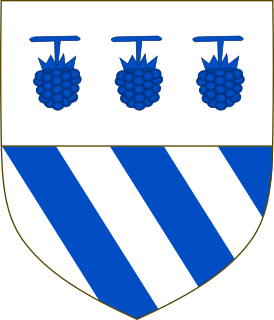
The House ofMòro is a patrician family of the Republic of Venice and one of the founding families of the city in 434.

The Zulian were an old Venetian noble family. The place from whence the Zulian came to Venice is unclear; however, the family is considered one of the first that moved to Venice, and thus one of the oldest Venetian and Italian noble families. The family produced tribunes, and in the early 8th century gained dukedom, as a family member rose to the position of Maestro dei cavalieri. The family produced several prominent Venetian figures, including statesmen, generals, patrons and magnates.
Giuseppe Tassini was an Italian historian and one of the most notable scholars of the toponymy of his birthplace of Venice. His most notable work was Curiosità Veneziane, a minute toponymical study first published in 1863 and universally considered the most important bibliographical source of its kind.



















